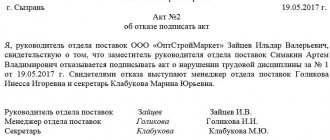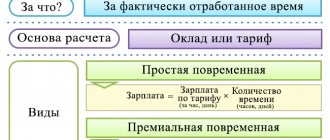Each employer must approve internal labor regulations (ILR) and familiarize staff with them. If the organization or individual entrepreneur hiring employees does not have such a document, this may lead to negative consequences during inspections by the labor inspectorate. Legislation changes periodically, and PVTR needs to be adjusted to new requirements. 2021 is just the right time to make changes to these rules.
What are the Rules for?
This regulatory document establishes:
- procedure for hiring and dismissing employees,
- work and rest schedule at the enterprise,
- conditions for the provision of bonuses, benefits, financial assistance,
- procedure for sending employees on vacations, business trips,
- obligations and rights of the parties, etc.
The document is written based on the needs and capabilities of the organization, taking into account the regulatory legal framework based on articles of the Labor Code of the Russian Federation and state standards and can contain any number of points.
The main objective of the Rules: to promote the competent distribution and use of working time, strengthen labor discipline, increase the efficiency of the production process, etc.
It should be noted that not all enterprises in the commercial sector use the Rules in their personnel records, which today is not a violation of the law. There is only one important condition: the relationship between the employer and subordinates must fit within the framework of the current legislation.
Articles on the topic (click to view)
- What is taken into account when imposing a disciplinary sanction
- How long does it take for a disciplinary sanction to be lifted?
- What are the consequences of disciplinary action at work?
- How long is the duration of a disciplinary sanction?
- Minutes of the general meeting of the labor collective: sample 2021
- Order to lift a disciplinary sanction: sample 2021
- Order on violation of official duties: sample 2021
But state budgetary institutions are required to use these Rules in their work, and their drafting is regulated to the smallest detail.
The internal regulations apply to all personnel of the organization, regardless of the position of a particular employee, so everyone must be familiarized with them upon signature.
Expert opinion
Polyakov Pyotr Borisovich
Lawyer with 6 years of experience. Specialization: civil law. More than 3 years of experience in drafting contracts.
The drafting of the Rules must be treated with extreme care, since in some cases they can become evidence in court when resolving labor conflicts and disagreements, both on the part of the employer and the subordinate.
In order to put the Rules into effect, the enterprise must issue an order on behalf of the manager. Moreover, if the company has a trade union organization, its representatives must be familiar with the Rules even before their approval.
What to include in routine rules
Since there is no standard structure of the rules, each employer decides independently which sections to include. The main thing is that the document works, that is, disciplines employees and prevents labor disputes. Typically, the PVTR includes at least those sections that are described below.
Let us note that the document often reflects not only the aspects left by law at the discretion of the employer, but also the provisions of the Labor Code of the Russian Federation themselves. This approach is acceptable, because any employee would do well to familiarize himself with the provisions of the Code before concluding a contract. However, when drawing up the PVTR, the main attention should be paid to those issues that the employer must resolve.
Next, we will look at the main sections of the document, and at the same time we will talk about the changes to the PVTR that should be made from 2021.
General provisions
General information is usually written at the beginning of the document. Here it is necessary to indicate that the rules are drawn up in accordance with labor and other legislation, and their norms apply to employees of the organization or individual entrepreneur. It would also be useful to prescribe the purpose of the PVTR - and this is to protect the rights of both parties to the labor relationship and prevent controversial situations that are not regulated by the Labor Code of the Russian Federation. If the rules contain specific terms, these can also be described at the beginning of the document.
Hiring and firing procedures
The rules for hiring employees and their dismissal are prescribed in chapters 11-13 of the Labor Code of the Russian Federation, that is, when drawing up this section of the PVTR, you should first of all focus on them.
Here you need to indicate which documents need to be submitted when hiring. The first thing that needs to be added to the rules in 2021 is a provision on the right of an employee, along with a work book, to submit information about work experience in the form STD-R or STD-PFR. This change is being made in connection with the introduction of electronic work books and is due to the provisions of Article 66.1 of the Labor Code of the Russian Federation. It can be indicated that from 2021, paper books will not be opened for persons who begin working activities.
Here you can describe what additional documents are needed for employment. For example, if a vacancy requires special knowledge, in addition to the standard set, you need to submit a document confirming its availability. However, it is impossible to demand from the employee documents that are not specified in Article 65 of the Labor Code of the Russian Federation, and in some cases - in other laws. That is, the employer should not request from a new employee, for example, a tax identification number or a certificate from a previous place of work.
A fairly common phenomenon is a probationary period. If the employer has established it, then a clause about it must also be included in the PVTR. However, the organization’s procedures should not worsen the position of the hired person in comparison with the conditions established in the Labor Code. Accordingly, the probationary period cannot exceed: six months - for the heads of the organization or its branch, chief accountants and deputies of these persons, three months - for all others. Establishing a longer probationary period will violate the Labor Code of the Russian Federation.
The rules also need to include the procedure for obtaining documents upon termination of an employment contract. And here is another change in the PVTR that needs to be made in connection with the introduction of electronic work books. It is necessary to indicate that if an employee refuses a paper work record in favor of an electronic one, he will receive information about work activity in the STD-R form.
They are issued upon a written application from the employee, which must indicate the form of provision - paper or electronic. If STD-R is requested on the day of dismissal, then it should be issued at the same time. Any employee who has switched to an electronic work record book (and not just those resigning) can request information, but in this case it must be provided within three days.
It would also be useful to reflect the procedure for obtaining documents by an employee who was absent on the last day of work, especially given the widespread use of remote employment.
Rights and obligations of the parties
An employee has the right to count on work in accordance with the contract, a safe workplace, wages, protection of his rights, insurance and other guarantees. At the same time, he must conscientiously fulfill his labor duties, including work rules, discipline, established labor standards, and labor protection requirements. He should also treat the employer’s property with care and report emergency situations that threaten life, health or property.
The employer, in turn, has the right to demand that employees perform their duties, take care of property, encourage them and hold them accountable. He is obliged to provide hired persons with work and means of production, pay for their work, inform and familiarize them with adopted local acts, create conditions for their activities, including satisfying household needs, insuring and compensating for damage caused.
This is only part of the rights and obligations of the parties to the labor relationship. All the rest can be found in Articles 21 and 22 of the Labor Code of the Russian Federation. They can be taken as the basis for this section of the PVTR. Employers should refrain from imposing unnecessary responsibilities on employees, as well as limiting their rights. For example, you cannot shorten lunch hours, prohibit leaving the office building during a break, and the like.
One of the rights of workers is to undergo medical examination. If such provisions are included in the PVTR, they should be adjusted. In 2021, employees over 40 years old have the right to a one-day medical examination once a year (younger colleagues have this right once every 3 years). Average earnings are calculated for this day. It must be indicated that the employee can take a day off once a year for this purpose by notifying the employer in advance (for example, 3 days in advance) and must agree on the date with him. He is also required to submit a certificate after medical examination within a certain period. If this rule is not written down, then it is impossible to demand a certificate and count absenteeism for its absence.

Operating mode
In the section on work and rest schedules, it is worth describing the following points in as much detail as possible:
- beginning and end of the working day/shifts;
- duration of the working day in hours and working week;
- number and duration of breaks within the day;
- working hours for employees with irregular working hours.
In connection with the coronavirus pandemic in 2020-2021, Rospotrebnadzor made recommendations to ensure social distancing in the workplace. Therefore, in many enterprises, workers work in shifts, in a modified mode. This must be enshrined in an additional agreement to the employment contract. It is also worth including these rules in the PVTR, describing the new format of work in as much detail as possible. You can specify that the mode is introduced under certain conditions (for example, when the recommendations of the on-load tap-changer are in effect), and by default the normal order applies.
Another innovation that needs to be reflected in the PVTR in connection with changes in the Labor Code of the Russian Federation is remote work. Many organizations have transferred their employees to this regime in whole or in part. The main points should be indicated:
- type of remote work (temporary, permanent or combined - now all these forms are enshrined in the Code);
- the ability of the parties to discuss and specify in the additional agreement to the contract the address of work (usually at the employee’s home);
- procedure and frequency of communication (messengers, telephone, email);
- the procedure for exchanging documents, including using an electronic signature, as well as the procedure for its receipt and use;
- the procedure for informing an employee about local acts, including leave, dismissal, and so on.
Remuneration and bonuses
This section states that wages are calculated according to the employer’s payment system and based on the staffing table. It is paid at least twice a month in proportion to the time worked, for example, as often happens, on the 5th and 20th.
Forms for rewarding employees are also indicated. These can be not only bonuses and other types of material incentives provided for by the Labor Code of the Russian Federation, but also any others. For example, training at the expense of the company.
Responsibility measures
In the provisions of the PVTR regarding liability, it is necessary to take into account the norms of Article 192 of the Labor Code of the Russian Federation. A common mistake made by employers is to introduce a system of fines and other similar punishments into the company. It is illegal. The Labor Code spells out all possible options for holding an employee accountable for violations, including failure to comply with labor regulations. This is a reprimand, reprimand and dismissal. The use of other disciplinary measures is prohibited.
When assigning punishment, the severity of the offense must be taken into account. For example, you can fire an employee if he repeatedly fails to fulfill or grossly violates his duties, skips work, or shows up at work drunk. But for a single failure to fulfill duties, a more lenient punishment is imposed.
Direct order issuer
An order to approve the Rules can be written by any employee of the organization whose job responsibilities include this function or by an employee authorized to formulate orders by a separate order of the manager. It could be:
- legal adviser,
- head or HR specialist,
- secretary, etc.
After drawing up the form, it should be given to the director of the organization for approval - without his signature it will not be considered valid and it can be easily challenged through a court or labor inspectorate.
An order for approval of the Internal Labor Regulations must be drawn up both during the initial formation of the document and in cases where any changes have been made to the Rules or they have been completely “reformatted”.
This is important to know: Order on violation of official duties: sample 2021
Document retention periods
It is legally established that internal labor regulations must be stored in accordance with the List of standard management archival documents for one year from the moment they lose their force. It is recommended to store together with this local act and the order for its entry into force.
In most cases, a local act is an annex to the order by which it is put into effect. In this regard, the order approving the internal regulations must be kept for the entire period of validity of the Rules, as well as for another year if they are declared to have lost their validity as a result of the entry into force of new regulations.
Tags: Order
Rationale and basis for creating an order
Like any other administrative document, this order must have some basis, i.e. justification and basis.
The substantiating point in this case is the reason for creating the order, i.e. the need of the company that the document solves (for example, to organize the activities of the work team, prevent labor conflicts and disputes, etc.).
As a basis , you can refer to the clause of the law of the Russian Federation, which regulates the creation of internal labor regulations.
Nuances of document preparation
The order does not have a single unified model approved at the legislative level. So enterprises and organizations can write it in free form or according to a template approved within the company. In this case, there is a number of information that must be indicated in the document:
- number, date,
- place of compilation,
- full company name,
- basis for formation.
The order also needs to give a specific instruction, usually drawn up in the form of separate paragraphs. In this part, you should definitely include the number and date of preparation of the approved Internal Labor Regulations, as well as the date of their entry into force. All other information is prescribed based on the needs of the enterprise.
It is necessary to note the employees responsible for its implementation (these issues are usually controlled by the personnel officer), and as an appendix, indicate the rules themselves and, if necessary, other attached documents.

What to pay attention to when placing an order
There are no special requirements for the execution of the order, as well as for its content: it can be written by hand (with a ballpoint pen of any color, but not with a pencil) or printed on a computer. To create a document, both the organization’s letterhead and a simple blank sheet of paper are suitable.
Expert opinion
Polyakov Pyotr Borisovich
Lawyer with 6 years of experience. Specialization: civil law. More than 3 years of experience in drafting contracts.
Only one condition must be observed: the order must be signed by the head of the company or his representative and the employees responsible for its implementation.
Today, it is not necessary to certify a form using a seal or stamp, since the use of stamp products is no longer a norm prescribed by law, even for legal entities (the exception is those organizations in which the obligation to use seals and stamps is approved in internal regulations).
Procedure for applying the order
Internal labor regulations are a regulatory act of an organization in which it determines what time employees should work and what periods are rest time.
In addition, in this document the company can consider other issues that arise between the administration and its hired personnel when carrying out activities.
Specialists from various professions may be involved in the development of these Rules. Moreover, when accepting the final version, it is desirable that each of them put their visa on the document as approval.
This is important to know: Disciplinary action: how to formalize it correctly
Once a draft local regulation has been created, it must be put into effect accordingly. As a rule, an order approving internal labor regulations is used for this purpose.
Before approval, the created regulatory document must also be sent for approval to the trade union bodies of the business entity, if they exist.
It must be remembered that this regulatory act of a company can be either an independent document, or it can be used as an annex to the main local act, for example, to a Collective Agreement. In the latter case, there is no need to issue an order approving internal regulations.
Most often, such a duty to compile is assigned to the organization’s personnel service or office management department. They prepare a draft order, and the responsible official signs it.
Such a procedure can only be carried out by persons authorized to do so by the charter, for example, a director. It is necessary to take into account that the introduced internal regulations come as an annex to the order by which they are put into effect.
After the order is issued, the entry “Approved” is marked with a special stamp on the Rules, and the details of the issued order to enter this document are indicated.
What is PVTR
Internal labor regulations are a local act, that is, a document drawn up by the employer. This may be a separate document or an annex to a collective labor agreement. In essence, PVTR is a set of instructions regulating issues that, in accordance with the Labor Code, must be resolved by the employer. For example, what operating hours should be established in the company, how to reward employees, and whether to assign a probationary period when hiring.
The legislation does not establish any specific form or structure for the PVTR, so the document can be drawn up arbitrarily. It is then approved by order of the manager or individual entrepreneur. The rules are mandatory for use by all employees, so each person hired must be familiarized with them and signed before concluding an employment contract.
All employers – organizations and individual entrepreneurs – must develop and approve the PVTR.
Payroll and personnel records
order approving PVTR
Let's look at an example of how you can draw up an order approving internal labor regulations.
The law does not establish a special form for it, so companies can draw it up in any form using company letterhead.
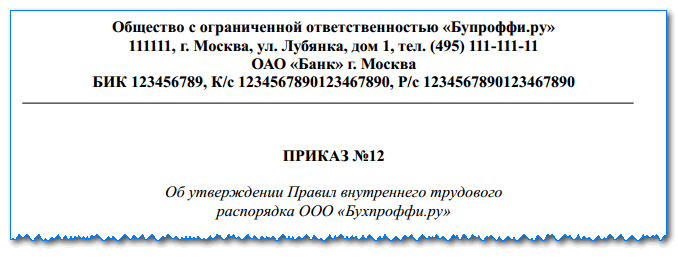
Otherwise, the preparation of the document must begin by recording the full name of the company, its address and details. Next, you need to indicate the name of the document and its serial number. In the future, the form will need to be registered under it in a special order book.
Below on one line at different ends of the sheet you need to write down the place and date of compilation.
Then, on a new line in the middle, the full name of the order is indicated.
Next from a new line comes the introductory part of the order. It is necessary to justify why it was decided to introduce these rules. This could be, for example, “For the purpose of regulating issues of organizing working conditions, and maintaining discipline at work and in production.”

Expert opinion
Polyakov Pyotr Borisovich
Lawyer with 6 years of experience. Specialization: civil law. More than 3 years of experience in drafting contracts.
In the same part of the order, one can mention the provisions of the Labor Code of the Russian Federation, which regulate the correct execution of these actions. After this, the word “I order” is indicated on a new line.
Next, the manager’s orders are indicated point by point:
- Approval of the drawn up rules and indicate the date from which they should take effect;
- If the enterprise already had rules, and a new version of them is being put into effect, then the old rules must be declared invalid from the date the new ones are introduced;
- Indicate that employees must be guided by them when performing daily duties;
- Determine the official who will be responsible for familiarizing all company employees with the new rules. This must be done under signature;
- It can also be separately established that it is necessary to familiarize all employees hired at the enterprise with the rules, and also determine who will do this;
- Identify a person who will monitor the execution of this order.
As an appendix to the order, you need to write down the details of the draft rules, as well as the number of pages it occupies.
A fully completed order approving internal labor regulations must be signed by the head of the company. Be sure to write down his position and personal data next to the signature.
This is important to know: Order to impose a disciplinary sanction: sample 2021
If the order appointed responsible employees, then at the bottom of the order it is necessary to provide columns on which they could put their signatures, transcripts and dates of familiarization.
How to correctly draw up an order approving internal labor regulations
Let's look at an example of drawing up an order to approve the rules.
The law does not define any special form for it. Therefore, organizations can draw it up in any form, including using a company letterhead.
Typically, the preparation of an order must begin with the full name of the business entity, location address, and registration codes.
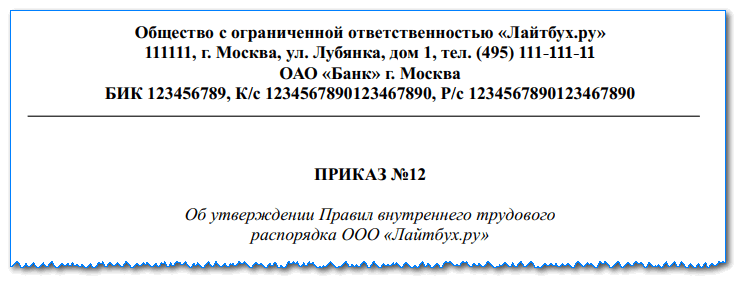
Then the name of the document and its serial number are written down. Under these data, the document will need to be recorded in the order register for the enterprise.
The next step is to record the place where the order was drawn up and the date on which it was made.
Next, the name of the order is written on a new line. Then comes the text of the order. First, you need to justify the reason why you decided to draw up and start using the Rules.
For example, you can write the following line: “For the purpose of regulating issues of organizing working conditions, and maintaining discipline at work and in production.” Here it is advisable to provide links to articles from the Labor Code that regulate these actions of the administration.
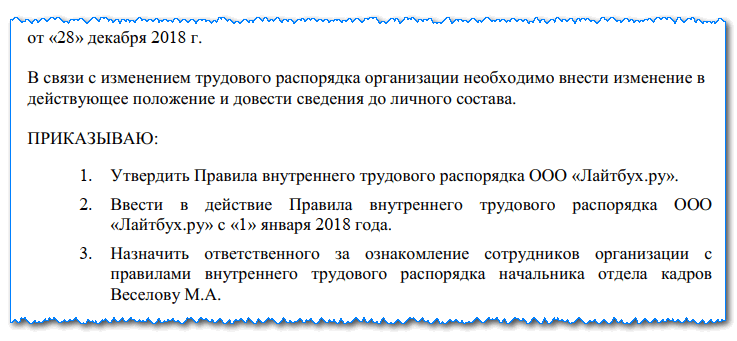
Next, separately on a new line you need to put the word “I order”, after which you need to list the manager’s orders in the form of a list.
Here you can enter the following:
- Approve the developed rules and put them into effect from a certain date.
- When some rules are replaced by a new version, it is necessary to declare the old similar local act invalid in the order.
- Establish that this document should be used in everyday work, regulating the work schedule of employees.
- Establish a responsible person who will be entrusted with monitoring compliance with the rules and the procedure for familiarizing with this local act. It is important to remember that familiarization must be carried out against the signature of the manager.
- Separately, it is necessary to bring the norms of this act to the attention of incoming new employees. It is also recommended to identify a responsible employee here.
- Appoint a person responsible who will monitor the execution of this order of the manager.
In the approval order, you can set the period during which these internal rules will be in force in the company. However, if this is done, then after this period it will be necessary to develop and put into effect new rules.
Attention: if the Rules are put into effect by order, then they are an appendix to it. Therefore, in the text of the order itself, it is necessary to indicate that there is an appendix to it and record the number of sheets of the Rules.

The order must be certified by the manager, who affixes his visa, position, and personal information.
All persons who were designated in the order as responsible must also affix their signatures and decipher their full names, as well as indicate the date of familiarization with this document.







